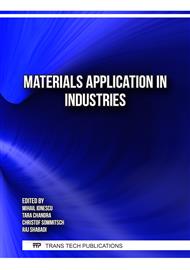[1]
T. Kobayashi, T. Ando, Recent development of joining and conductive materials for electronic components, Mater. Trans. 62 (2021) 1270-1276.
DOI: 10.2320/matertrans.mt-m2021060
Google Scholar
[2]
J. Rickerby, J. H. G. Steinke, Current trends in patterning with copper, Chem. Rev. 102 (2002) 15251550.
Google Scholar
[3]
C. Jinsong, G. Jian, Q. Mingbo, Y. Jianming, H. Dazhi, W. Xiaoli, D. Yunfei, Preparation of Copper-Based Superhydrophobic Surfaces by Jet-Electrodeposition, Mater. Trans. 59 (2018) 793798.
DOI: 10.2320/matertrans.m2017361
Google Scholar
[4]
M.W. Liang, H.T. Yen, T.E. Hsieh, Investigation of electroless cobalt-phosphorous layer and its diffusion barrier properties of Pb-Sn solder, J. Electron. Mater., 35 (2006) 1593-1599.
DOI: 10.1007/s11664-006-0153-6
Google Scholar
[5]
M. Ganesan, C.C. Liu, S. Pandiyarajan, C.T. Lee, H.C. Chuang, Post-supercritical CO2 electrodeposition approach for Ni–Cu alloy fabrication: An innovative eco-friendly strategy for high-performance corrosion resistance with durability, Appl. Surf. Sci., 577 (2022) 151955.
DOI: 10.1016/j.apsusc.2021.151955
Google Scholar
[6]
T. Kobayashi, I. Shohji, Fabrication of three-dimensional microstructure film by Ni–Cu alloy electrodeposition for joining dissimilar materials, Mater. Sci. Forum, 1016 (2021) 738-743.
DOI: 10.4028/www.scientific.net/msf.1016.738
Google Scholar
[7]
G.B. Darband, N. Lotfi, A. Aliabadi, S. Hyun, S. Shanmugam, Hydrazine-assisted electrochemical hydrogen production by efficient and self-supported electrodeposited Ni–Cu–P@Ni–Cu nano-micro dendrite catalyst, Electrochim. Acta, 382 (2021) 138335.
DOI: 10.1016/j.electacta.2021.138335
Google Scholar
[8]
T. Kobayashi, A. Kubo, I. Shohji, Formation of Cu–Ni alloy plating film for improving adhesion between metal and resin, Mater. Trans. 63 (2022) 800-804.
DOI: 10.2320/matertrans.mt-mc2022002
Google Scholar
[9]
T. Kobayashi, I. Shohji, Joining process of dissimilar materials using three-dimensional electrodeposited Ni–Cu film, Mater. Manuf. Process. 36 (2021) 10761083.
DOI: 10.1080/10426914.2021.1885708
Google Scholar
[10]
J. M. Lee, J. S. Ko, Cu–Ni alloy electrodeposition on microstructured surfaces, J. Mater. Sci. 50 (2015) 393-402.
DOI: 10.1007/s10853-014-8598-0
Google Scholar
[11]
Z. Liu, L. Guo, C.L. Chien, P.C. Searson, Formation of a CoreShell Microstructure in Cu–Ni Thin Films, J. Electrochem. Soc. 155 (2008) D569-D574.
DOI: 10.1149/1.2946709
Google Scholar
[12]
Z. Lia, H. Bian, C.M. Lee, X. Chen, Y.Y. Li, Nickel nanotube array via electroplating and dealloying, Thin Solid Films, 658 (2018) 1-6.
DOI: 10.1016/j.tsf.2018.05.015
Google Scholar



